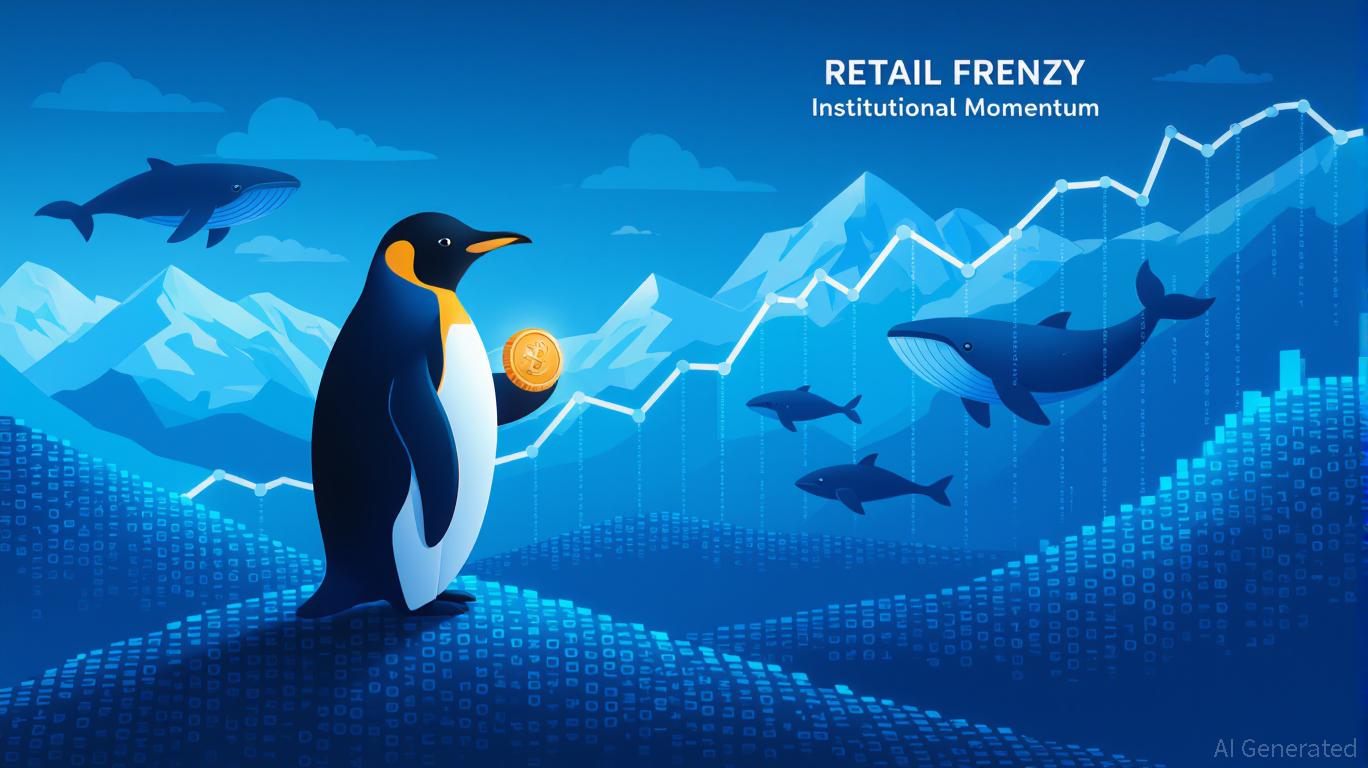Momentum ETF Soars Following Record-Breaking Institutional Investment
- Institutional investors poured $377B into Momentum ETFs in Q3 2025, doubling 2020-2024 average flows. - AI-driven tech rallies and Fed rate cut expectations fueled demand for growth equities via momentum strategies. - ETFs' tax efficiency and liquidity advantages enabled dynamic portfolio rebalancing amid macroeconomic uncertainties. - Historical parallels to 2013-2018 bull markets suggest institutional flows signal structural growth equity cycles. - Balanced fixed-income allocations in Q3 2025 indicate
Understanding Momentum: Institutional Investment Patterns and Market Forces
Since mid-2024, institutional investments in Momentum ETFs have surged, propelled by two main drivers: the AI-fueled boom in tech stocks and expectations of interest rate reductions by the Federal Reserve. In Q3 2025, large-cap stocks led the way, attracting nearly $94 billion into momentum-centric funds, while small-cap stocks experienced an unusual revival as investors anticipated lower borrowing costs
The so-called Magnificent 7—including companies such as Nvidia and Palantir—have played a pivotal role in this transition. These firms now represent a significant portion of the S&P 500’s beta, attracting institutional investments through both passive and active ETF vehicles
Looking Back: Historical Patterns and Lasting Changes
The current Momentum ETF inflows are consistent with historical bull runs in growth stocks. Over the last ten years, growth-oriented ETFs have regularly outperformed their value counterparts, holding a record $57 billion advantage as of October 2025
Importantly, ETFs offer structural benefits such as tax advantages, real-time liquidity, and lower fees, making them the preferred choice for institutional investors navigating turbulent markets
Bullish Signals: Institutional Moves as Market Indicators
Institutional accumulation of Momentum ETFs often serves as a bellwether for broader market confidence. In bull markets, institutions tend to allocate capital early to high-conviction growth assets, betting on sustained outperformance over several years. The current surge into momentum strategies—particularly those centered on AI and semiconductor sectors—resembles the early phase of the 2013–2018 bull market, when thematic ETFs outshined broader benchmarks
Nevertheless, this pattern is not without its dangers. The 2025 downturn in momentum ETF returns—prompted by the fall of previously dominant names like Tesla and Broadcom—demonstrates the vulnerability of highly concentrated approaches
Conclusion: Redefining the Bull Market
The record-setting institutional embrace of Momentum ETFs marks a fundamental change in how growth stocks are valued and allocated. Propelled by supportive macroeconomic factors (like rate cuts and AI integration) and innovations in ETF structures, this period signifies a broader evolution in bull market behavior. While history warns against excessive concentration in high-growth areas, the present institutional enthusiasm for momentum strategies indicates that investors are anticipating a prolonged expansion in risk assets.
For those investing in growth equities, the message is unmistakable: the institutional pivot toward Momentum ETFs is not a short-lived phenomenon but a foundational indicator of a new bull market era. As active ETFs continue to outperform their passive peers and thematic investing gains momentum, the momentum strategy is set to remain a key element in institutional portfolios. The main challenge will be maintaining a balance between strong conviction and prudent risk management—a balance that recent inflows into fixed-income ETFs suggest institutions are already striving to achieve.
Disclaimer: The content of this article solely reflects the author's opinion and does not represent the platform in any capacity. This article is not intended to serve as a reference for making investment decisions.
You may also like
The Psychological Factors Influencing Retail Investors’ Actions in Cryptocurrency Markets
- Crypto markets are shaped by behavioral finance, where retail investors drive volatility through FOMO, herd behavior, and overconfidence. - The PENGU token exemplifies this dynamic, surging 480% in July 2025 but plummeting 28.5% by October due to emotional trading cycles. - Social media amplifies emotional contagion, with traders checking prices 14.5 times daily, while financial literacy mitigates bias susceptibility. - Personality traits like neuroticism increase cognitive biases, and speculative narrat

Bitcoin News Today: Bitcoin's Unstable Holiday Periods Hide Average Gains of 6%
- Bitcoin's Thanksgiving-to-Christmas performance shows equal odds of rising or falling, with a 6% average seasonal return despite volatility. - Historical extremes include a 50% 2020 rally and 2022's 3.62% drop post-FTX collapse, amid a $2.49-to-$91,600 long-term surge since 2011. - 2025's $91,600 price reflects ongoing recovery from 2024's $95,531 peak, with institutional crypto adoption and macroeconomic factors shaping future trajectories. - Analysts advise dollar-cost averaging for retail investors, w

Australia Strikes a Balance Between Fostering Crypto Innovation and Safeguarding Investors with Updated Regulations
- Australia introduces 2025 Digital Assets Framework Bill to regulate crypto platforms under ASIC, creating "digital asset platform" and "tokenized custody platform" licenses. - The framework mandates custody standards, transparency requirements, and lighter regulations for small operators (<$5k per customer) to balance innovation with investor protection. - Global alignment with UAE and EU crypto regulations is emphasized, while addressing risks from past failures like FTX through stricter enforcement and

PENGU Token's Latest Price Fluctuations and Blockchain Indicators: An Analytical Perspective on Technical Factors and Institutional Activity
- PENGU token's recent volatility and on-chain activity spark debate over institutional involvement in the crypto market. - Technical indicators show conflicting signals: overbought RSI vs. positive MACD/OBV momentum since November 2025. - Whale accumulation and Solana integration suggest strategic buying, while team wallet outflows highlight market uncertainty. - Social media sentiment drives short-term price swings, but structural risks like tokenomics and regulatory ambiguity persist. - Institutional ad
